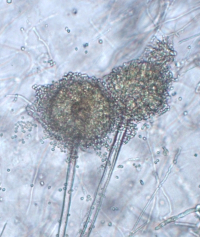Ways/Opportunities of Decontamination Processes of Surface Moulds and Mycotoxins
A special issue of Processes (ISSN 2227-9717). This special issue belongs to the section "Biological Processes and Systems".
Deadline for manuscript submissions: closed (31 March 2023) | Viewed by 24159

Special Issue Editors
Interests: microbiological safety of food and feed
Special Issue Information
Dear Colleagues,
Many fungal species grow on the surface of different substrates and cause processes which often contribute to spoilage, alterations of technological properties, modifications of material nutritive value, the development of mycosis and allergy agents, and the production of mycotoxins. Mycotoxins are a group of secondary metabolites produced by filamentous fungi which may contaminate food, feed, or raw materials used in their production, thus causing mycotoxicoses in livestock, domestic animals, and humans. Taking into account their often co-occurrence as also toxic and synergistic effects in the body, investigations of surface moulds and mycotoxins are of huge public health importance. The genera of mycotoxigenic fungi are mainly represented by Aspergillus, Penicillium, Fusarium, and Alternaria. The production process of mycotoxins is stimulated by certain environmental factors and therefore the extent of contamination differs with geographical location, implemented agricultural methods and conditions, as well as the susceptibility of commodities to the penetration of fungi during storage and processing periods. Among the hundreds of known mycotoxins, special attention is paid to aflatoxins, ochratoxins, and the Fusarium mycotoxins fumonisin, zearalenone, deoxynivalenol (DON), and T-2/HT-2 toxin, as they contaminate many different types of foodstuffs of plant and animal origin and occur all over the world. Previous research suggests that elevated carbon dioxide concentration, the increase of temperatures, and the occurrence of extreme droughts and rainy periods have a significant impact on mould growth and the appearance of mycotoxins. Therefore, because of the huge economic losses and health hazards which can be caused by toxicogenic moulds and mycotoxins, it is of great importance to develop nonharmful methods for their elimination or decontamination in agriculture and industry.
This Special Issue on “Ways/Opportunities of Decontamination Processes of Surface Moulds and Mycotoxins” aims to present novel advances in the knowledge of processes of mycotoxinogenic mould distribution and mycotoxin production, as well as their control and elimination from food and feed. Topics include, but are not limited to:
- Conditions of surface moulds growth and possibilities of their removal;
- Environmental and other conditions for mycotoxins production;
- Mycotoxin co-occurrence and synergistic effects in humans and animals;
- The development of nonharmful methods for mycotoxin control and elimination from food and feed.

Dr. Manuela Zadravec
Prof. Jelka Pleadin
Guest Editors
Manuscript Submission Information
Manuscripts should be submitted online at www.mdpi.com by registering and logging in to this website. Once you are registered, click here to go to the submission form. Manuscripts can be submitted until the deadline. All submissions that pass pre-check are peer-reviewed. Accepted papers will be published continuously in the journal (as soon as accepted) and will be listed together on the special issue website. Research articles, review articles as well as short communications are invited. For planned papers, a title and short abstract (about 100 words) can be sent to the Editorial Office for announcement on this website.
Submitted manuscripts should not have been published previously, nor be under consideration for publication elsewhere (except conference proceedings papers). All manuscripts are thoroughly refereed through a single-blind peer-review process. A guide for authors and other relevant information for submission of manuscripts is available on the Instructions for Authors page. Processes is an international peer-reviewed open access monthly journal published by MDPI.
Please visit the Instructions for Authors page before submitting a manuscript. The Article Processing Charge (APC) for publication in this open access journal is 2400 CHF (Swiss Francs). Submitted papers should be well formatted and use good English. Authors may use MDPI's English editing service prior to publication or during author revisions.
Keywords
- moulds
- mycotoxins
- mycotoxin production
- mycotoxin elimination
- decontamination
- implementation of nonharmful methods
Benefits of Publishing in a Special Issue
- Ease of navigation: Grouping papers by topic helps scholars navigate broad scope journals more efficiently.
- Greater discoverability: Special Issues support the reach and impact of scientific research. Articles in Special Issues are more discoverable and cited more frequently.
- Expansion of research network: Special Issues facilitate connections among authors, fostering scientific collaborations.
- External promotion: Articles in Special Issues are often promoted through the journal's social media, increasing their visibility.
- Reprint: MDPI Books provides the opportunity to republish successful Special Issues in book format, both online and in print.
Further information on MDPI's Special Issue policies can be found here.






